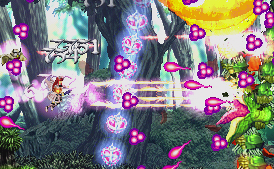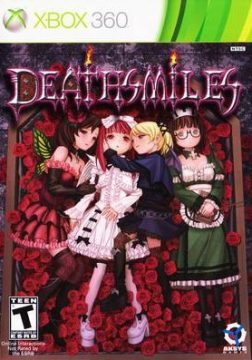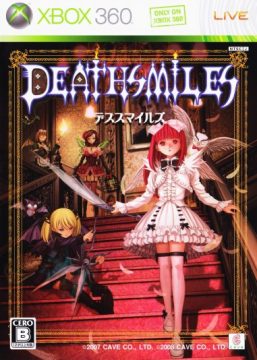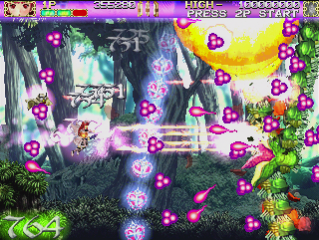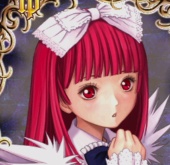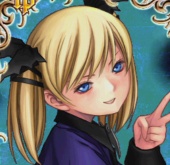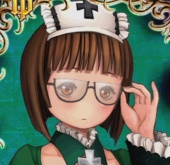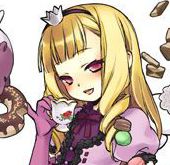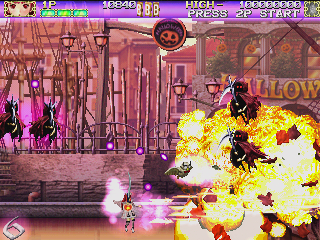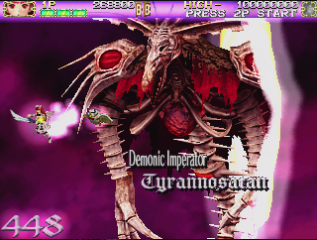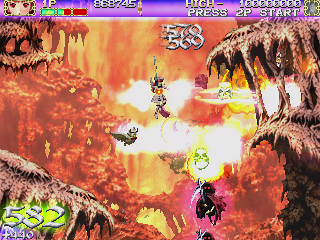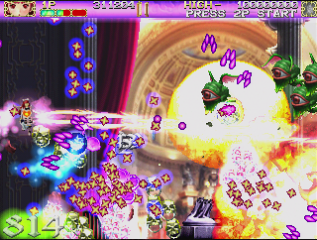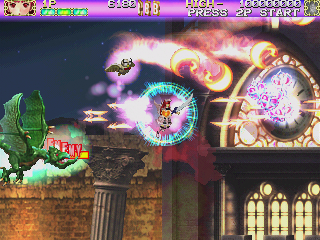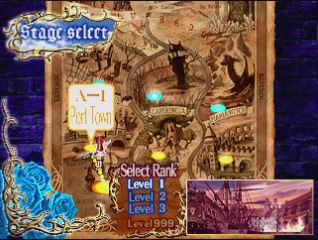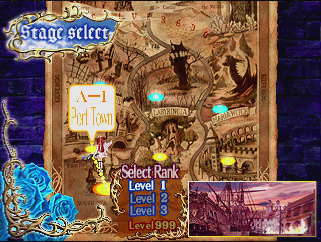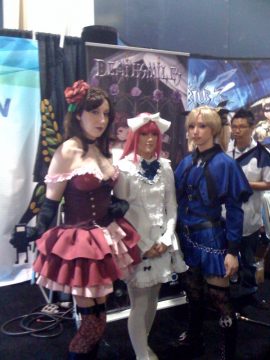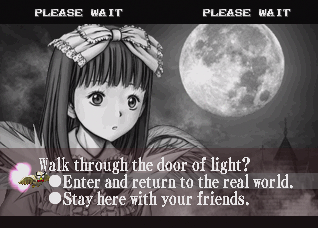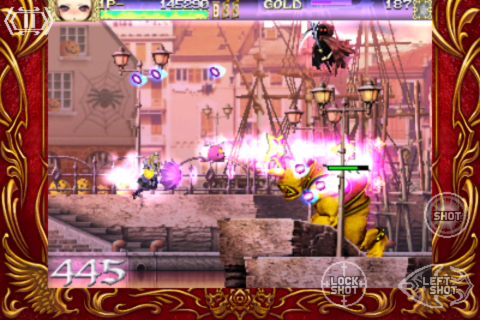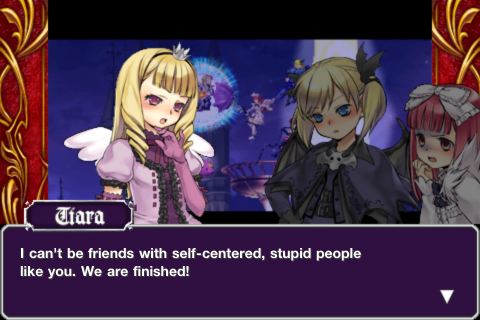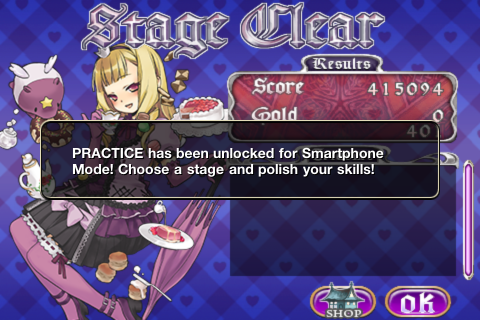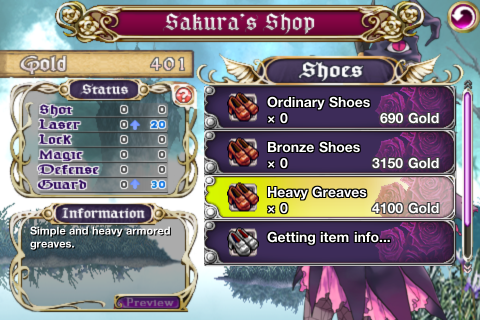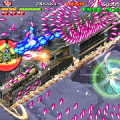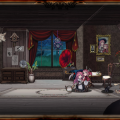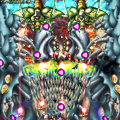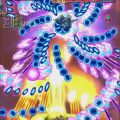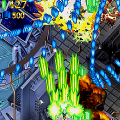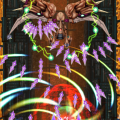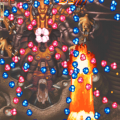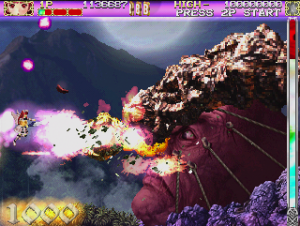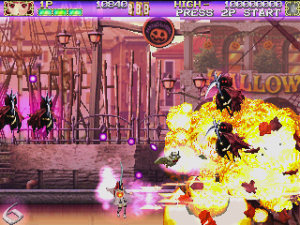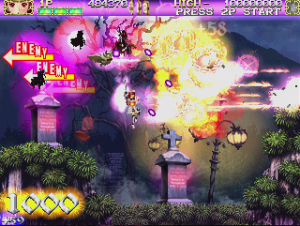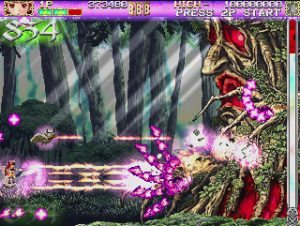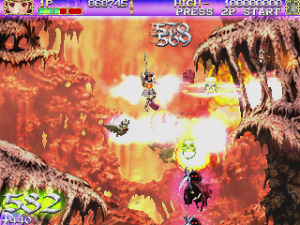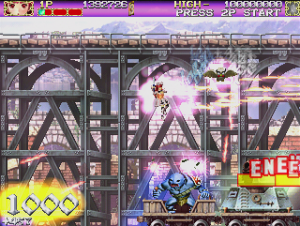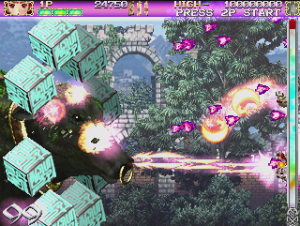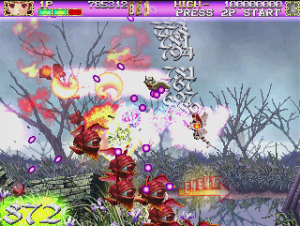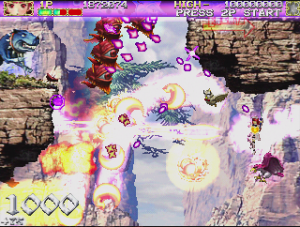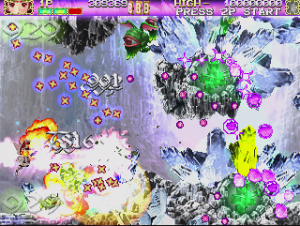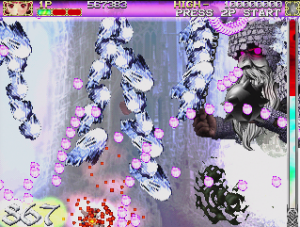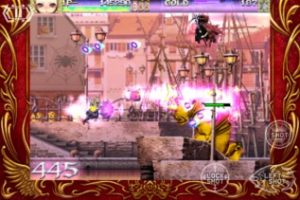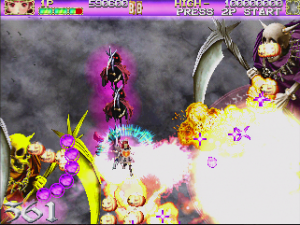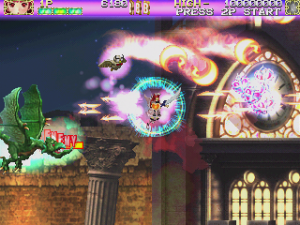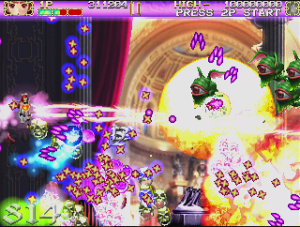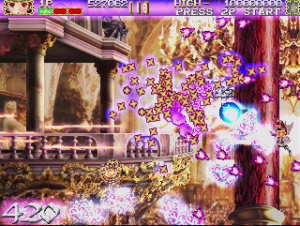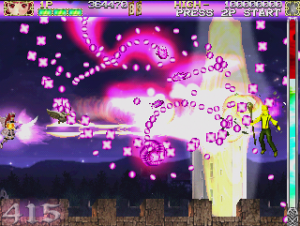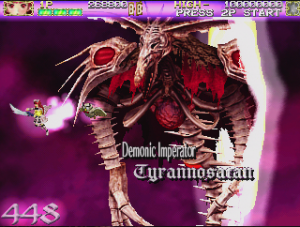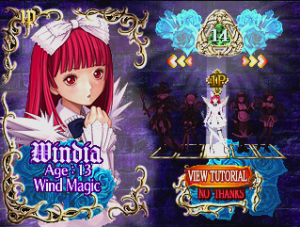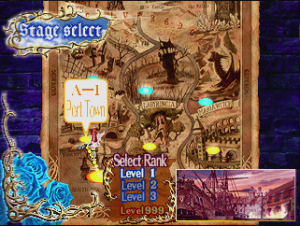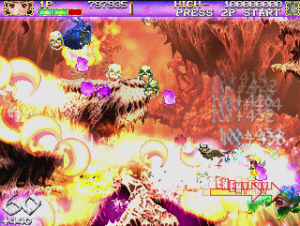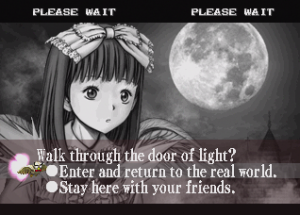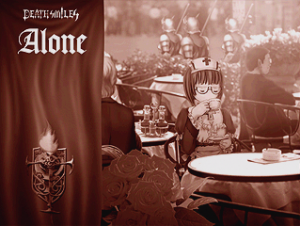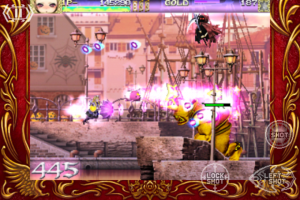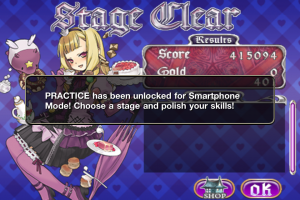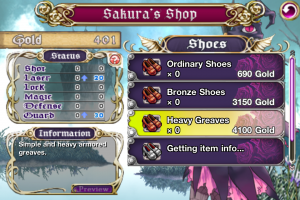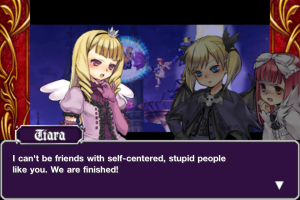- Deathsmiles
- Deathsmiles II
As the scrolling shooter, long an arcade mainstay, quietly followed its native venue into obscurity, diehard fans found some solace in an offshoot niche aimed squarely at their sensibilities – this intimidating subset, trademarked by crowded, hard-to-navigate screenfuls of unfriendly bullets, came to be known as danmaku (literally “bullet curtain”), and eventually grew prominent enough to embody the “old-school shooting” genre at large in the minds of many, guaranteeing itself a limited, if self-satisfied, audience. Today, even as the contemporary gaming landscape appeals ever more openly to new and “unconditioned” demographics, shoot-em-ups have remained, with few exceptions, resolutely elitist, unwilling to re-submit themselves to the masses that rejected them.
Enter Shinjuku-based developer Cave (an acronym for “Computer Art and Visual Entertainment”), foremost among a small remaining handful of shooter-centric game companies and arguably the defining icon of “bullet hell” to enthusiasts. While its “core” player base has kept business humming for 15 years and counting, even this rather remote corner of the gaming world can only resist the influence of a shifting consumer pool for so long. The ever-more-urgent question for a company like Cave has been, in a nutshell, “How does one create an arcade-style shooter that can appeal to less-experienced players without alienating the veterans that got us here?” The answer, as it turns out, is simpler than you’d think: just pack in enough variables, divergences, and options to allow almost anyone to tailor the experience to their liking.
That, and gothic lolitas.
Deathsmiles, against all odds, has had an unprecedented effect on Cave, its audience, and the modern scrolling shooter as a whole – while its unflinching appeal to more, um, “specialized” marketing sectors has left a bad taste in the mouths of many, it’s hard to root against its stated purpose of returning the once-prolific shmup to a less-isolated state of existence, rebuilding its long-forgotten appeal to non-diehards without abandoning what makes the genre special in the first place.
In an interview following the release of 2001’s Progear, Cave’s first “side-scrolling” danmaku project, lead programmer Tsuneki Ikeda (often referred to as “IKD”) opined that, in retrospect, horizontal shooters “aren’t really suitable for bullet-dodging” – this appeared to signal a permanent return to the company’s standard vertical screen orientation. A few years down the road, however, for his latest shoot-em-up IKD determined to revisit the sideways view after all, though with a different goal in mind: now intent on appealing to customers normally put off by “hardcore” shoot-em-ups, he pitched a concept for the game that later became Deathsmiles, one whose action was “busy” but “not a danmaku“, specifically instructing lead programmer Takashi Ichimura (who’d served in similar capacity on Dangun Feveron and Ketsui) to “get away from that Cave-like feel”.
Moreover, while many scrolling shooter developers (and most “core” fans along with them) over the years have treated plot and characters as negligible (if not altogether unnecessary) within the genre, Deathsmiles places its cast storyline squarely front-and-center, to the point where they’ve gained semi-infamy among industry press. The in-game lore tells us that certain “lost children” who suddenly and tragically vanish from our world without a trace are actually “spirited away” to a hidden land of magic known as Gilverado: while its mystical atmosphere grants these special individuals extraordinary powers, none are ever able to return home afterwards. One longtime resident of this strange place, a kindly old man named Count Dior, has taken it upon himself to adopt those “lost children” bearing particularly strong potential and train them to defend Gilverado from evil forces: Dior’s so-called “angels”, who all just so happen to be young girls clad in garb of questionable taste, comprise Deathsmiles‘ playable cast.
Characters
Windia
The newest-arrived “angel”, she originally lived in London but was kidnapped en route to school one day, disappearing in a flash of light as soon as she began to fear for her life – she’s still coming to terms with her new surroundings, and gets emotional easily. Accompanied by a dignified owl familiar named Hoo, she isn’t especially powerful but is relatively easy to use, and well-suited for familiarizing oneself with Deathsmiles‘ mechanics.
Casper
Youngest of the group, Casper can’t remember the specific circumstances which brought her from Berlin to Gilverado – this repressed trauma has made her hesitant to open up to others and rather difficult to deal with personally. She and her bat-like familiar Kiki are generally a bit trickier to master than Windia, though their attacks inflict more raw damage, especially if you can get in close.
Follett
Hailing from Paris, the quiet, bookish Follett was caught up in an icy river’s overflowing current before being spirited away, manifesting fiery powers in her desperation to dispel the cold: appropriately enough, her given companion is Bobo, a baby dragon whose flames suffer from a short range but pack a strong punch. Not playable by default, she requires a code to unlock.
Rosa
Dior’s first “angel” and eldest (for whatever it’s worth) among them all, she serves as something of an unofficial leader to the squad, though her easygoing, unserious approach to even major crises isn’t always appreciated. A violent car crash in her native California flung her across the void, barely alive, but thanks to Dior’s care she soon wielded a potent piercing shot and a fairy helper named Tee-Tee; like Follett, she’s hidden from the selection screen until manually enabled.
Sakura
Boss of the “swamp” level, playable only in the game’s “Mega Black Label” variation. Despite her Japanese name she’s actually English, and even knew Windia in the “real” world: another auto accident punched her ticket to Gilverado, but unlike the other girls her parents were also in the car, and were transported with her. Unfortunately, fearful native residents chased the family to the land’s uninhabited outskirts before the Count even knew they’d arrived; her father coldly ran off soon afterwards to seek a way back, leaving Sakura to watch over and defend her ailing mother alone. Two birds, Karko and Kuta, work together as her familiars.
Tiara
Not actually an “angel” at all, Tiara is a Gilverado native… the parasol-packing regal princess of the land, to be precise. Despite a tendency to come off as rather cold at first blush, she desperately wants to contribute to the fight against the evil forces invading her domain; unfortunately, unlike the angels, she has no magical abilities…until she happens upon a small, porcine creature named Mu, who ends up serving as her in-game attendant. Though her character “debuted” on a spinoff Drama CD (in which she searches for a way to gain the same powers as the angels’), she eventually garnered enough popularity to serve as the star of the portable edition’s “iPhone mode”.
While the prominently-displayed underage girls clad in not-enough-frills on Deathsmiles‘ promotional materials are more than enough to put many on edge, once the action gets going in earnest such thematic elements will easily become a non-factor for those who’d rather ignore them. As in most shooters, the in-game character sprites, while detailed, are still too small to unduly emphasize any naughty bits, and their appearances will matter even less as you focus on guiding your character’s tiny central hitbox (conveniently displayed as a glowing heart) through the enemy’s assaults. Beyond this, one or two of the inter-stage and/or ending images are really about the only in-game distractions that could still possibly put you off: if you can live with these minor inconveniences (along with a small handful of mid-game dialogue sequences which can be fast-forwarded, but not skipped entirely), then you should have no trouble playing Deathsmiles as you would any other shooter.
That’s not to say, of course, that there’s nothing “normal” people will be interested in eyeing up here. IKD’s original concept for Deathsmiles also envisioned a specific visual theme, namely “Gothic horror with a light feel”: the artwork and designs by longtime Cave collaborator Junya Inoue (aka “Joker JUN”; he also provides the voice for one of the bosses), implemented onscreen via Cave’s signature spritework, nails this atmosphere with panache. Every backdrop from the misty graveyard to the festive port town to the corpse-strewn forest is packed with ornate (and sometimes destructible) set pieces, though the player is never made to feel outright repulsed or frightened – each locale is also populated, of course, by scads of adversarial creepy-crawlies to shoot down. Floating eyeballs, cleaver-wielding pig chefs, bristling hellhounds and ground-shaking cyclopes alike put on a fine show throughout, right up to the moment they’re blown to smithereens with a satisfying boom, screech, or crunch.
Deathsmiles‘ bosses are especially impressive: both your eyes and your hands will be busy keeping up with the flying boulders churned up by Jordan the buried giant or the grotesque, grinning apples that Whroon the ghost tree flings your way, though the bellows of Mary the colossal cow(?!) will probably reverberate in your memory the longest. Some major baddies even change form depending on the chosen difficulty level (more on that in a minute); Bavaria, the dragon boss of the volcano, grows an extra head to menace you with, for instance.
On the aural front, storied video game composer Manabu Namiki (whose hand is present in everything from Battle Garegga to Metal Slug to Trauma Center to Odin Sphere) capably completes the mood, spicing up the pipe organ flourishes and tinny strings you’d expect with catchy electronic accents – a handful of brief, spooky background voiceovers are also sprinkled in, including a semi-recognizable one sampled from 1966 exploitation film Mondo Keyhole. If you can reach the final boss, however (a friendly fellow named Tyrannosatan, because “regular” Satan just wouldn’t cut it), Namiki is content to step aside and allow Bach’s iconic Toccata and Fugue in D Minor to say all that needs be said of the encounter.
If, by now, you’ve come to grips with Deathsmiles‘ atypical presentation, you’re probably curious as to how it plays. First and foremost, the game eschews its genre’s longtime tradition of limiting most attacks to a single direction: players are given two separate “shot” buttons, one to fire to the left and the other to the right, a style seldom implemented since Capcom’s Side Arms in 1986. While this “dual shot key” setup might take one or two practice runs to get used to, most other control aspects should feel pretty natural to anyone who’s ever played a shoot-em-up before.
As in many Cave titles tapping either “fire” button shoots “normal” bullets, while holding it down releases a more powerful “focused” array but reduces your movement speed. Your character’s tsukaima (“familiar”) critter companion acts as an ever-present (and invincible) “option” turret, providing supporting fire and the ability to block certain special types of enemy bullets – when using certain characters it orbits you during normal movement but freezes in place when you “focus”, while with others these functions are reversed. Finally, holding down both “shot” keys at once enables a “lock shot” which automatically targets single enemies within range, while a third button activates a limited stock of “smart bombs” to clear the screen and get out of tight spots.
While the player’s perspective remains “sideways” throughout, the game actually scrolls in a variety of directions, and enemies can suddenly appear from any which way: thankfully, things are balanced out by your ability to freely attack to either side, as well as a brief warning marker which pops up wherever an adversary is about to enter, saving you the frustration of being blind-sided too frequently. If you do happen to run headlong into someone nasty, you only lose half of a life marker, while touching “neutral” obstacles doesn’t damage you at all – eating a bullet subtracts one life instantly, but your attack power always stays constant, so there’s no need to worry about being stuck with a pea-shooter if you mess up.
Refreshingly user-friendly as these features are, Deathsmiles‘ biggest draw of all, especially for non-shmuppers, is the ability to individually adjust each stage’s challenge level. The game’s six initial locations are divided into two sets of three, and can be tackled in any order provided you alternate your choices between the “A” and “B” groups: more importantly, there are three distinct difficulty settings to choose between for each. Newbies should have a good chance of completing a “Level 1” area in one piece, thrill-seekers can stick with “Level 3” all the way through, and everybody else can mix and match as they see fit. Players will eventually be shut out of the lower difficulties as they progress, and the final stage (plus an unlockable optional “extra” area) can’t be softened at all, but this variable is still a great boon to casual fans who need to be eased into the game’s mindset, and allows Deathsmiles to serve as one of the few modern shoot-em-ups well-suited for mixed-skill two-player sessions.
Once you’re comfortable with the basic ins and outs of Deathsmiles, it’s time to get greedy: after all, what’s any shoot-em-up without the ability to rack up high scores and show off a bit? While Cave has made sure to keep the scoring system simple enough for greenhorns to grasp, they certainly haven’t forgotten the battle-hardened shoot-em-up fan either. As you fly along wreaking havoc, you’ll notice that many enemies leave behind collectibles after being shot down, which contribute to a so-called “main counter” in the bottom left corner of the screen when picked up: skulls increase the number a little bit, while silver crowns boost it several times faster.
Which item you get from each target is dependent on the attack you use to defeat it: some enemies drop the more valuable crowns when blasted by “regular” shots, others cough them up when downed with “focused” attacks, and still other surrender the most loot when killed with a “lock-on” assault (don’t overdo it, though, as using the lock-on slowly drains the counter), so a bit of experimentation is required to figure out what to use on which foe for maximum profit. Once you’ve amassed enough stuff, the onscreen ticker will finally top out at 1,000 – so now what? Press both “shot” buttons at once when your item stock is maxed and all will become clear:
“POWER UP!”
Congratulations, you’ve just entered “power-up mode”: onscreen enemy bullets are snuffed out, all of your character’s attacks become stronger, defeated adversaries leave behind a lot more goodies, and flying directly into (non-boss) baddies no longer damages you (though their bullets still will, obviously). The catch is that your item counter constantly decreases while you’re “powered up”, so you’ll want to make the most of each such opportunity while it lasts: also, try not to over-abuse your attacks or drop any bombs if you can help it, as this behavior drains your supply much faster (though this “penalty” can actually be used to your advantage, as will be explained shortly). Oh, one other important thing to remember while in “power-up mode”: every item you collect now earns you bonus points, and the more stuff you can snag before the boost runs out the more each trinket is successively worth, up to 10,000 additional points a pop.
There’s a trick to maxing this bonus out quickly: while you were collecting items in “normal mode”, you probably noticed that when a crown dropped to the ground it would split into several skulls, which could still be collected but weren’t worth as much. All of this changes when powered-up: when it comes to boosting the “overall counter” up to 10,000, the type of item collected no longer matters, only the raw quantity. It sounds a bit complicated on paper, but score-based play is quite easy to grasp when boiled down to the essentials: basically, when not “powered up” collect everything in midair if possible, but after powering up let it drop and scatter before swooping in. If you manage to max out the multiplier enemies will start to leave behind super-valuable golden crowns which can “split” even further, and the points REALLY start to pile up.
Once “power up mode” ends the process basically starts over again; crafty players, however, can manipulate the game rules to stay “powered up” almost constantly, via a technique known as “recharging”. By carefully timing their progress to ensure that their item stock runs out at certain spots where mass items can be spawned, they use their remaining power to fill the screen with treasure before being forced back into “normal” mode (or expending a bomb to instantly revert): as soon as that happens, they collect all those remaining onscreen items, and the “main counter” is instantly back up to 1,000 (or close to it), leaving them free to power up again right away.
This technique is tricky to pull off and takes practice to set up correctly, so don’t be frustrated if it’s difficult to pin down at first: in any event, mastery isn’t necessary for clearing the game (one can score enough points to earn both “extend” lives without it), so less-confident types can feel free to ignore it, saving “power-up mode” for spots they’re having trouble with instead of blowing it on high-score opportunities. One final note about playing Deathsmiles for score: while each character’s potential in this area is a bit uneven, everyone is granted a separate records table, so there’s still good reason to spend some time learning what’s possible with the entire cast.
About a year after the game’s initial arcade release, as they’ve done on a handful of other occasions, Cave decided to release a small amount of “revised” Deathsmiles boards, on slightly upgraded “SH3b” hardware, under the title Deathsmiles Mega Black Label (because, of course, “regular” Black Label just wasn’t good enough). Based in part on a non-commercial board called Deathsmiles DIE, which was only ever playable at certain company events, in most respects it’s the same game, but there are a handful of additions catering mostly to devoted fans: Sakura is now a playable (and powerful) character, a new optional area (the “Ice Palace”) is selectable, players can “power-up” with as few as 500 items in stock, the “overall counter” is now displayed more clearly and does not reset upon powering down (though it does drain slowly between charges), and both an extra hidden final boss and an even crazier “Level 999” difficulty (because simply moving up to Level 4 just wouldn’t…aw, forget it) are available for the truly masochistic. Few people ever got to play “MBL” in its original form, though Cave would soon see fit to change that.
A couple of months following the release of “Mega Black Label”, Deathsmiles received a home port to the XBox 360 in Japan – while Cave handled its programming in-house, some observers were still uneasy about its prospects following the outsourced fiasco of DoDonPachi Dai-Ou-Jou Black Label X. Fortunately, this time things turned out pretty well: the original arcade version is reproduced faithfully, stand-alone controller buttons for rapid fire and the lock shot can be mapped, and both hidden characters and the optional “Canyon” level are unlocked from the start. To round out the package there are two alternate modes to try: one of them is “360 Mode”, which is identical to “Arcade Mode” in most respects, but all six initial stages can now be played at any difficulty level with no “lockout”, some slowdown has been removed, and the artwork and sprites have been redone to look better on high-definition screens (backgrounds remain untouched, however).
Then there’s “Version 1.1”, which implements the same graphical upgrades as 360 Mode alongside several other changes, the foremost being the ability to directly control your familiar’s movement: you’ll be making frequent use of this, as enemies and bosses now assail you with extra “suicide bullets” upon being attacked (in previous versions of the game this would only happen on high difficulty settings), and only your helper can absorb them to prevent you from being completely overwhelmed.
On the bright side, canceled suicide bullets become collectable items, and skillful manipulation of a dangerous area can fill you up in no time: the fact that you can now power up with a measly 100 items in stock, and that your point multiplier can soar ten times higher than before (insane scores ahead!), offers extra incentive to cheat death and pig out. Basically, be prepared for lots of screen-clogging mayhem. “Mega Black Label” was also made available on the 360 as paid DLC, featuring its own “Arcade” and “360” modes, though a “1.1” variation could also be purchased separately; be advised that slowdown levels are reduced compared to the arcade original throughout.
The 360 port also includes a full-featured Training mode, online co-op, internet leaderboards, replay saving/uploading/downloading, and a good selection of screen-tweaking options for different displays, so competitive sorts have plenty of motivation to train hard and show off their best: customers who sprung for the more expensive Limited Edition got different cover art and an arranged soundtrack CD, while all first-print buyers received a DLC voucher card for “full voice” content, which adds spoken dialogue to the cutscenes. The initial print run sold well enough to spawn a budget-priced “Platinum” reprint a year later: this edition doesn’t include the “full voice” card or AST, but does feature Mega Black Label (minus MBL 1.1) right on the disc, which more than makes up for it, especially at the reduced cost of entry.
Not long afterwards Deathsmiles was, to the complete surprise of many, picked up for release in the U.S.A. by Aksys Games: this occasion marked the first time a Cave shooter had ever been localized by an overseas publisher, and non-Japanese fans rejoiced at the prospect. Even more amazingly (well, perhaps not for the people who brought over Record of Agarest War), Aksys did not water down or censor any of the game’s more “unpalatable” subject matter: to the contrary, they openly embraced it, setting up a Twitter account for Windia and adopting the tagline “Death smiles at us all. Lolis smile back”, as if to dare Fox News (or anyone else who might give them some extra publicity) to react.
As with Agarest, all first-print Deathsmiles copies were “Limited Editions”, containing an arranged soundtrack CD and a decorative system faceplate (of course, the “slim” 360 redesign hit shelves around this time, rendering the latter bonus item useless to anyone who’d upgraded), though the package still retailed for a bit less than most new releases. Aksys couldn’t resist posting an April Fool’s ad for a non-existent 300-dollar “BDSM Uber Edition” as well; it supposedly featured man-panties, replica angel wings, a whip and collar, and an oversized coffin-shaped box (“because we don’t want you putting your games on your shelves at home”). Deathsmiles even made an appearance at the publisher’s PAX East booth that year, complete with a handful of understandably uncomfortable-looking cosplay models: to their credit, they at least had a sense of humor about the whole situation.
When release day finally arrived press reviews were encouragingly positive, and initial impressions by the rank-and-file followed suit: every feature of the overseas port had been left intact (though this version’s leaderboards were separate from the Japanese ones), and all of the Mega Black Label DLC content (1.1 included!) was available on-disc: the only real “editing” present involved the game’s few bits of text dialogue, which were “remixed” to give the girls some ridiculously over-the-top (but thankfully unvoiced) regional accents.
Upon digging in a bit further, though, long-time fans were surprised and largely disappointed to discover that slowdown levels had been reduced for all modes, causing most areas, especially on higher difficulties, to play faster (and tougher) than in the arcades or the Japanese 360 port. To be fair, these changes don’t make Deathsmiles‘ U.S. edition unplayable or unbeatable, but do render it incompatible with the original for score attacking; Aksys’ official explanation claimed that Cave themselves altered the programming to better represent their “ideal” vision for the game, but notwithstanding several months later a patch was issued that, among other things, re-implemented most of the original slowdown.
Around the same time as the aforementioned patch was issued, European publisher Rising Star Games finally delivered a PAL localization of Deathsmiles to fans across the pond. As with the U.S. version all of the Mega Black Label content is included on-disc, though this one’s first-print “Deluxe Edition” instead packs in an original (non-arranged) soundtrack CD and a PC “desktop accessory set” previously available only in Japan; more importantly, the complaints of American players have been duly noted, as both the embarrassing text dialogue and missing slowdown are not issues here. The music CD was slightly screwed up, released as a data disc full of .WAV files that wouldn’t work in a “traditional” player, though Rising Star did offer to send a replacement to anybody who asked for one: other than this minor flub, the game’s similarly warm reception by both critics and shooter enthusiasts was well-deserved.
After all of this, Deathsmiles was also released for Windows in 2016, along with Mushihime-sama and Dodonpachi: Daifukkatsu. It’s mostly the same as the Xbox 360 port, right down to the initial release missing the accurate slowdown, with a later patch finally fixing it up a bit. All three of the game’s soundtracks (the OST, the Arrange Album, and the Manabu Namiki Selection Premium Arrange Album) are available as DLC.
Four years after its debut Deathsmiles also earned itself an overdue translation to the iPhone and iPad, the third Cave arcade port to make the trip. The expected set of modes, namely a straight-up “Arcade” and an exclusive “iPhone” variation, are here, as are “Practice” settings to fine-tune your skills and compatibility with both OpenFeint and Game Center. Unlike its predecessors there’s no neutral “movement bar” area set aside for your finger to control character movement with, so it can be a bit trickier to keep your digits out of the way of the onscreen action, but the “button” layouts for attacks are a bit more user-friendly than they were in its predecessors. “Arcade” is pretty much what you’d expect, with a few adjustments: the Final and “EX” levels can now be played on easier difficulties, “power up” mode lasts longer, an “auto-bomb” is available, and the text translation has been (re-)redone.
iPhone mode is another creature entirely: not only have both the character art (now rendered by mangaka Yukinatsu Mori) and soundtrack (remixed by Takeshi Miyamoto, AKA Kizakura) been given a new coat of paint, but an exclusive solo playable character, Tiara, has replaced the original cast (the latter make brief appearances, but aren’t selectable). Unlike the other girls, she can be outfitted with a wide variety of items to increase her stats (including “defense”, as the traditional three-life setup has been replaced by a health bar): this equipment can be obtained either as random drops from defeated enemies (including bosses, if you can “seal” them via a quick “match-the-pattern” sequence at the end of battle) or by spending the point items you collect at an inter-level shop. Stage layouts and enemy patterns are unchanged (though mid-sized enemies have been given visible health meters, which is nice), save for a new “True Last Boss” at the very end, but the higher challenge levels now need to be unlocked. While shoot-em-up purists tend to dislike this somewhat “grindy” aspect (especially since you can’t switch to a different character to change things up), others don’t mind the sense of progression, especially since better equipment is a prerequisite to survival farther in.
Imagine that, though… a phone-based game packed with scads of collectible stuff, some of which is essential for progression therein! Yeah, you probably knew what was coming next: a few weeks after the initial iPhone release an update appeared, containing bug fixes, a few new options and additions, and a fresh batch of items and perks, some of which can only be bought with real-life money. Several are just bits of Cave fan service (equipable weapons borrowed from DoDonPachi, Guwange, and other Cave titles), but a few (most notably the Lucky Charm accessory, which raises the drop rate drastically and is pretty much a necessity if you want a complete item collection) are tougher to go without. While it is possible to finish the game without any of the paid DLC, there’s still an unmistakable whiff of Farmville in the air, a somewhat depressing development for such a respected arcade presence.
Not surprisingly, Deathsmiles‘ innate appeal to a wide audience and its reliance on characters instead of faceless jet planes lend themselves especially well to shameless merchandising, and Cave is certainly not one to let such an opportunity go to waste: for “serious” fans, two “superplay” DVDs showcasing professional high-score runs were released (the standard game’s edition features an interview with Joker JUN, while the “Mega Black Label” footage is packaged separately alongside Mushihime-sama Futari‘s own “Black Label” superplay), and peripheral manufacturer Hori put out a joystick featuring Deathsmiles artwork. On other fronts, a series of radio-play “Drama CDs” (three so far, at least one more still to come) complement the stand-alone soundtrack, while Japanese fans on XBox Live can spring for an array of themes and Gamerpics (though no other region has seen these yet, strangely enough).
Collectors, of course, tend to covet the more specialized trinkets, especially those sold primarily at Cave’s occasional “Matsuri” events in Akihabara – keychains, cell phone straps, posters, “uchiwa” fans, postcards, an official art book, a resin model kit, and at least one full-body pillowcase are floating around and commanding exorbitant sums. Most infamous among them all, however, is a papercraft game printed on the back of an arcade flyer, which involves blowing air to lift a skirt off a pair of disembodied legs – stay classy, Cave! Fans, naturally, have also run with the brand, cooking up an array of doujinshi comics (most of them hentai, as you’d expect), and at least one (non-H, thankfully) tribute game, for Game Boy Advance hardware of all things, starring “vocaloid” Hatsune Miku, titled “Mikusmiles” (the creator isn’t technically an amateur, though, as he’s apparently done some work for Vanillaware, developer of Princess Crown and Odin Sphere).
Amidst all of the high-profile industry analysis, it’s amusing to wonder how many experts could have predicted that the downtrodden shoot-em-up would see a minor resurgence, especially with a title like Deathsmiles headlining it – petticoats and all, the game has made an undeniable impression on the genre’s self-image, expanded its creator’s market farther than ever, and most importantly reminded the gaming public that scrolling shooters are still here, still fun, and at long last ready to welcome them back.
Links:
Cave Official developer site (Japanese)
Aksys Games Official U.S. site
Rising Star Games Official European site
Official Cave blog (Japanese)
The World of Deathsmiles Translated interview and other materials at gamengai.com
Cave-STG Fan site with various info
